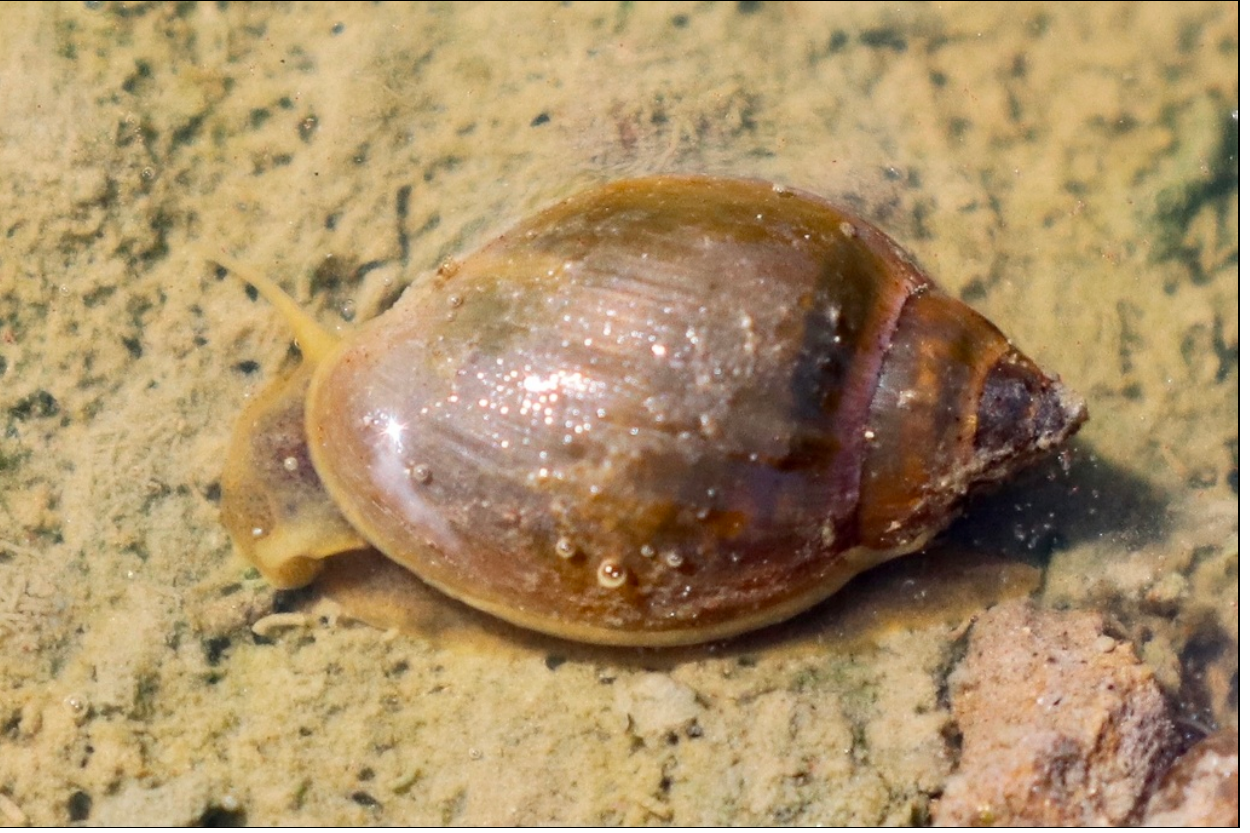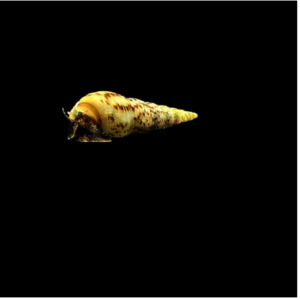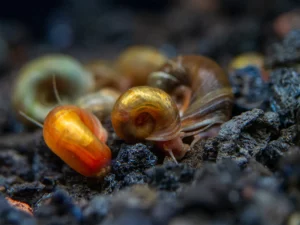Bladder snails have a mixed character, and their reputation will depend on who you ask. Some consider these critters awesome tank cleaners, while others see them as pests needing removal. Regardless of their reputation, these snails are a wonderful addition to tanks due to their ease of maintenance.
Bladder snails are small freshwater mollusks that reach an average size of 0.6 inches (1.5 cm) in diameter and 2 inches (5 cm) in length. These omnivores have a hearty appetite and primarily feed on algae and detritus. They reproduce by laying capsules that contain 40-100 eggs every three months.
This guide will help you understand the survival needs of bladder snails and provide tips on how to rear a healthy and happy population. Gain valuable insights into their appearance, lifespan, size, feeding habits, breeding, tank setup, compatible tank mates, and common problems.
Habitat and Origin
Bladder snails (Physidae sp) belong to a family of freshwater and brackish water gastropods. They are known by names such as:
- Pouch snails
- Tadpole snails
- Professional hitchhikers
They are called “professional hitchhikers” due to their remarkable ability to hitch rides and survive transportation. Unfortunately, this behavior has contributed to their reputation as invasive snails.
The bladder snail is believed to have originated in southwestern Europe, with the first documented sighting occurring in Portugal in the early 19th century. Since then, this species has spread worldwide and can be found in nearly every region.
While bladder snails can survive in marine and freshwater habitats, they prefer freshwater environments for breeding. They are considered freshwater species and exhibit impressive adaptability, thriving in various conditions, including:
- Freezing waters
- Polluted sewage waters
- Highly contaminated rivers
In the wild, bladder snails inhabit the surface of slow-moving waters and can be found in various locations such as:
- Rivers
- Ponds
- Lakes
- Swamps
Bladder snails rely on loose floating detritus for survival. These snails are primarily active at night, displaying nocturnal behavior as they search for food in dark underwater habitats. In essence, they are masters of adapting to diverse environments.
Among the bladder snail species, two are particularly common:
- Aplexa hypnorum, also known as the moss bladder snail.
- Physella acuta, commonly referred to as the acute bladder snail.
The latter, Physella acuta, is more prevalent and is often found in pet stores. This guide will primarily focus on this species, as it is readily available to aquarium enthusiasts.
Bladder Snail Appearance and Size
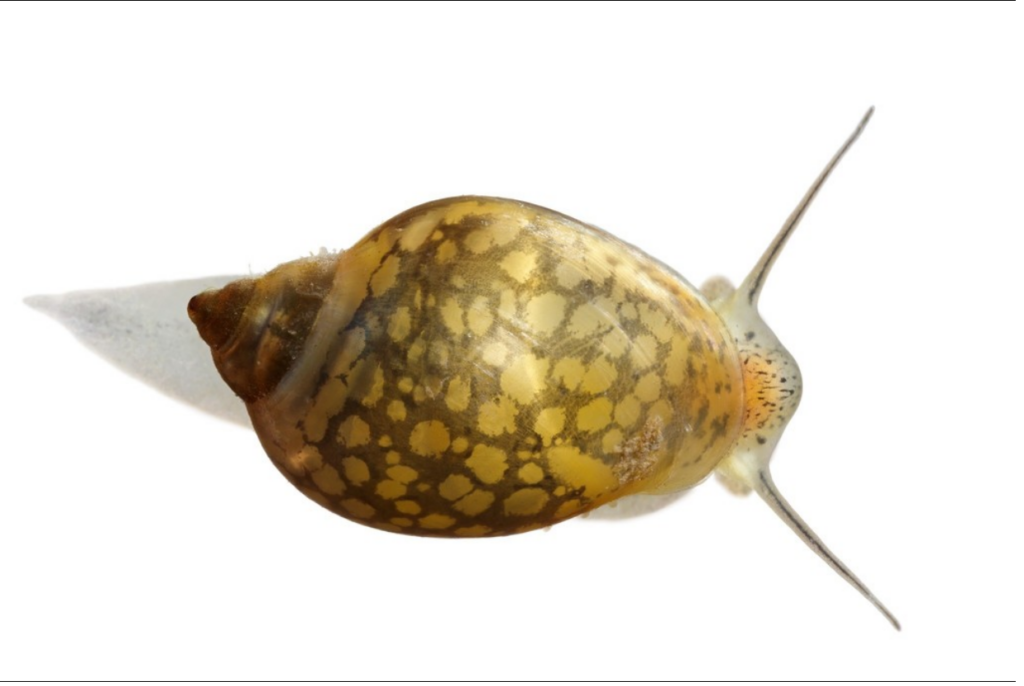
Bladder snails have thin, translucent shells that range in color from yellow to gold. These shells are so transparent that you can see the snail’s flesh and blood through them.
Some varieties of bladder snails even have distinct gold markings. The unique shape of their shell is egg-shaped with 3-5 left-spiraling whorls, a rare occurrence in the snail world known as sinistral.
At the front of their shells, bladder snails have a pair of thin tentacles with tiny black eyes at their base.
As pulmonary air-breathers, bladder snails rely on a lung to breathe. Their respiratory system allows them to easily float and swim in water.
When they need to restock air after extended underwater dives, they secrete a large air-filled bubble resembling a bladder, which is how they acquired their name. Additionally, bladder snails engage in cutaneous respiration, directly breathing through their skin.
Unlike some other snail species, bladder snails do not possess an operculum, a sturdy trapdoor that covers the shell opening and protects the snail’s fragile body from predators. Due to the absence of an operculum, bladder snails are more vulnerable to predation by animals such as:
- Betta fish
- Crayfish
- Loaches
- Adult shrimps
On average, bladder snails grow to a shell diameter of 0.6 inches (1.5 cm) and an overall length of 2 inches (5 cm). However, their size can vary depending on factors such as:
- Age
- Health
- Climate
In warmer climates, bladder snails tend to grow larger than those in colder regions.
Bladder Snails vs. Pond Snails
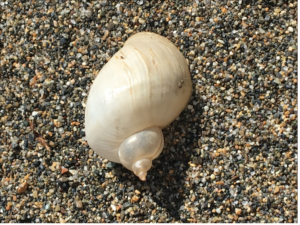
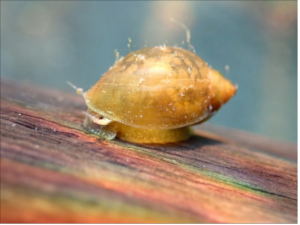
| Bladder Snails | Pond Snails | |
| Size | Smaller | Larger |
| Shell Coloration | Translucent, Yellowish | Opaque |
| Tentacles | Thin, thread-like | Thick, triangular |
Despite sharing physical similarities, bladder and pond snails can be easily distinguished. These two species differ significantly, starting with their size.
Pond snails are considerably larger than bladder snails, with the average pond snail being up to five times the size of a bladder snail.
Another distinguishing feature is the coloration of their shells. Pond snails have opaque shells that do not reveal their flesh, whereas bladder snails have translucent, yellowish shells that allow the snail’s flesh to be seen through them.
Lastly, their tentacles also differ in appearance. Pond snails have thick, triangular tentacles, while bladder snails have thin, thread-like tentacles.
Bladder Snail Lifespan
On average, bladder snails can live up to 2 years in captivity. In the wild, these versatile snails have been observed to have a lifespan of up to 3 years.
The life expectancy of bladder snails ultimately depends on their quality of life. Providing them with a proper diet and maintaining optimal water parameters can ensure a 2-year lifespan.
However, if they are subjected to improper diet, high water toxicity, and stress, bladder snails may succumb much earlier.
Buying Bladder Snails
- Excellent feeders for loaches, pufferfish, oscars etc.
- Reproduces easily in freshwater aquariums. Great live food starter colony.
- They do a very good job at eating algae and cleaning up after messy fish and plant litter
- Extremely high survivability. 3/16″ – 1/4″
- Caution ** Reproduces very fast.
I recommend purchasing bladder snails from One Stop Aquatics on Amazon. They are currently offering a pack of 10 live freshwater bladder snails. However, it is important to ensure that your water parameters are suitable for these snails before placing an order.
When purchasing bladder snails from pet stores, look for highly active specimens. Bladder snails are known for their high activity levels, often dashing across the tank.
It is not uncommon for them to float at the top of the tank for a short period. A dormant bladder snail is a cause for concern, as it may indicate sickness or nearing the end of its life.
Additionally, check the health of their shells. Opt for bladder snails with shiny, translucent shells, as discolored and opaque shells are a warning sign.
Furthermore, choose smaller bladder snails less than 2.5 inches (1 cm) in size, as these are younger individuals. Larger bladder snails are generally older; any snail larger than 2.5 inches may be quite old.
Bladder Snail Care
Tank Size
While bladder snails may be resilient, providing them with proper care is important. I recommend a minimum tank size of 2 gallons (8 liters) per bladder snail.
A minimum tank size of 10 gallons (38 liters) is recommended for community tank setups. The larger tank size allows for sufficient space for bladder snails to hide and live with minimal stress from predators. These snails are small and lack an operculum, making them relatively defenseless.
The Aqueon Standard Glass 10-Gallon Rectangular Tank from Amazon is an excellent choice for community tank setups. It offers clarity, durability, and scratch resistance, all at a reasonable price for a 10-gallon tank.
| Preview | Product | |
|---|---|---|

|
Aqueon Standard Glass 10 Gallon Rectangular Tank for Aquariums & Terrariums | Check Price |
Ideal Water Parameters
Bladder snails are hardy critters that can survive in various conditions. However, to promote good health and extend their lifespan, it is recommended to maintain the following water parameters:
| Parameter | Range |
| Temperature | 64°F-84°F (18°F-29°F) |
| pH | 7.0-8.0 |
| Hardness | 12-18 kH |
| Lighting | Normal community tank lighting |
While bladder snails are resilient and undemanding, it’s also important to consider other creatures in the tank. Some tank mates may not tolerate fluctuations in temperature and pH as well as bladder snails. Therefore, it is crucial to provide an environment suitable for all the inhabitants.
Vegetation and Substratum









Bladder snails are playful creatures with hearty appetites. Adding vegetation to the tank enhances the overall ecosystem, providing ample food for the snails and creating a conducive environment for their activities. When introducing plants, it is important not to overcrowd the tank.
Here are some recommended plant options for your bladder snail tank (links lead to Amazon):
- Hornwort (Ceratophyllum demersum)
- Red Root Floater (Phyllanthus Fluitans)
- Amazon Sword (Echinodorus sp)
- Java moss (Vesicularia Dubyana)
- Duckweed (Lemnoideae)
Any decorations you choose for your tank should be ideal as long as they do not release toxic materials into the water.
Bladder snails do not burrow, so choosing a substratum is not a major concern. You can opt for the following:
- Soft sand
- Gravel
- A few mid-sized rocks
Additionally, consider adding one or two pieces of driftwood. Utilize the wood and rocks to create small crevices and caves for the bladder snails to explore and hide in. However, always keep in mind the well-being of other tank inhabitants.
Feeding
Bladder snails are omnivores that primarily scavenge on algae and detritus within the tank. They do not feed on live plants but prefer decaying plant matter. However, they can become a threat to your plants if they are underfed.
Additionally, bladder snails will happily feast on deceased tank mates and leftover food on the tank floor. In community tank setups, there is often competition for food, and bladder snails may not receive sufficient nourishment from scavenging alone.
Therefore, it is necessary to provide food supplements in such setups. Here are some essential supplemental foods for your snails in a community tank setup (links lead to Amazon):
- Algae wafers
- Bottom feeder fish pellets
- Blanched vegetables (kale, spinach)
- Calcium-rich foods (cuttlebone, crushed eggshells)
- Spirulina flakes
- Snello
- Bloodworms
Any food that remains uneaten after 24 hours should be promptly removed from the tank to prevent the buildup of ammonia toxicity.
Decaying organic matter releases ammonia and nitrites, which can negatively impact water quality and create a toxic environment for tank inhabitants if left unattended.
I recommend reading the article “Can Snails Live in High Ammonia?” which provides insights into the tolerance of snails towards high levels of ammonia in their environment.
Calcium and Other Heavy Metals
Consider supplementing available calcium in your tank by adding calcium cubes once a week. Calcium is essential for the healthy growth of tank creatures, particularly snails, as it supports shell development.
I recommend using the Seachem Reef Calcium 500ml blend pellets for efficient calcium supplementation. These calcium-rich and fast-acting pellets can be easily added to your tank, ensuring an adequate calcium supply.
| Preview | Product | |
|---|---|---|

|
Seachem Reef Calcium 500ml | Check Price |
To maintain the right balance of calcium and prevent excessive levels of toxic minerals like copper in your tank, consider using the Seachem Cuprisorb 100ml copper and heavy metal removal kit. These pellets effectively remove copper and other heavy metals while helping to regulate calcium levels. This environmentally friendly product is fast-acting and user-friendly.
| Preview | Product | |
|---|---|---|

|
Seachem Cuprisorb 100ml | Check Price |
Suitable Tank Mates
Bladder snails are small and delicate, making them vulnerable to larger and more aggressive tank inhabitants.
Consider the following tank mates for bladder snails:
| Suitable Tank Mates | Unsuitable Tank Mates |
| Cory Catfish | Cichlids |
| White Cloud Mountain Minnow | Crayfish |
| Pictus Catfish | Large-sized shrimp |
| Diamond Tetra | Loaches |
| Pleco | Goldfish |
| Otocinclus Catfish | Betta fish |
| Nerite Snails | Pufferfish |
| Red Ramshorn Snails | |
| Gold Inca Snails | |
| Ivory Snails | |
| Bamboo Shrimp | |
| Amano Shrimp | |
| Ghost Shrimp | |
| Red Cherry Shrimp |
Breeding
Breeding bladder snails is a simple process that requires no intervention. These snails are hermaphrodites capable of self-fertilization. While they prefer cross-fertilization, they can easily reproduce through self-fertilization when suitable mates are unavailable.
After fertilization, the female bladder snail lays an egg capsule in hidden areas such as under plant leaves and crevices. Each capsule contains between 40-100 eggs, which hatch within a week.
The baby bladder snails are tiny but fully formed, with a visible miniature shell. With a reproductive cycle of every 3 months, bladder snails can rapidly reproduce, leading to overpopulation in a tank and causing various issues.
As a result, many aquarists consider this snail species to be a pest. Please note that the term “invasive species” refers to species that have a negative impact on ecosystems outside their native range.
While bladder snails can reproduce quickly in aquariums, they do not have the same harmful effects as invasive species in natural habitats.
Bladder Snails Common Problems
Bladder snails are generally hardy creatures that rarely experience health issues. However, their indiscriminate eating habits can make them prone to digestive problems.
Additionally, as carriers of vermin such as leeches and flukes, bladder snails can transfer these parasites to other tank inhabitants.
While this snail species is rarely affected by fish diseases, it is recommended to quarantine any bladder snail that displays suspicious behavior as a precautionary measure.
Discover the potential risks and implications of fish tuberculosis for snails in the article “Can Snails Get Fish TB?” Gain insights into the interactions between these organisms and the measures to prevent and manage the spread of this disease.
Closing Remarks
Rearing bladder snails can be a fascinating and fulfilling endeavor. These snails are easy to care for and can thrive in various environments. However, it’s important to manage their population as they reproduce quickly and are sought after by many tank inhabitants.
With your knowledge about bladder snail care, you may choose to introduce them to your tank, but ensure you select healthy specimens.
Let me hear your experiences and thoughts in the comment section below.
